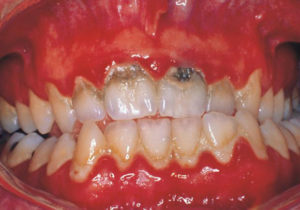 Dental plaques are a cluster of pathological microorganisms that are fixed on the enamel of one or several teeth at once.
Dental plaques are a cluster of pathological microorganisms that are fixed on the enamel of one or several teeth at once.
Similar bacterial accumulations in the oral cavity can form an acidic environment. In such conditions, the enamel begins to actively spoil, which leads to complete or partial destruction of the teeth.
Contents
- Localization and composition of dental plaques
- Where do bacterial accumulations form?
- Structure and composition of dental deposits
- Why the pathogenic microflora is formed
- Symptoms and stages of formation of dental plaques
- Symptomatic manifestations
- Stages of formation of dental plaque
- Methods of diagnosis of the disease
- What are the methods of treatment
- Removing dental plaques by the professional method
- Treatment at home
- What are the consequencescan lead to disregard of the disease
- Necessary methods of prevention
Localization and composition of dental plaques
Malicious clusters are formed on the enamel in the form of a light or dark plaque. They adversely affect the general condition of the tooth and can lead to its loss. This is due to the fact that they consist entirely of a variety of pathogenic microorganisms and products of their vital activity.
Where do bacterial accumulations form?
Clusters are often formed on the posterior walls of the teeth. Negative effects on the enamel lead to the demineralization of the posterior tooth wall and the formation of caries on it.
The fissures and blind holes are the most susceptible to the appearance of bacteria and caries. The touch can also affect the smooth parts that come in contact with the contact surface of the root.
Plaque formation is most often observed in those parts of the oral cavity, which are difficult to qualify for cleansing.
Structure and composition of dental deposits
It should be noted that such formations generally do not consist of food residues and again begin to form after 1-2 hours after brushing the teeth.
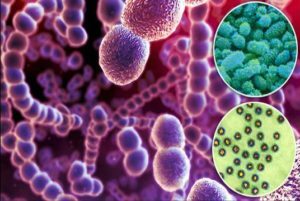
Streptococcus
The plaque is mainly composed of microbes. In a new layer of sediments, many small microbial forms inhabit that form a soft, sticky and slightly transparent coating.
50% of the microorganisms that make up the plaque are streptococci, 30% are diphtheria, the remaining 20% divide between youelonella, bactereroids, fusobacteria, Neisseria and vibrios.
Why the pathogenic microflora
is formed The causes of pathogenic deposits formation are:
- general resistance of the human body, as well as specific individual features of the immune system;
- abuse of sugar and sweet foods;
- Irregular brushing of teeth and non-compliance with hygiene rules;
- total volume and composition of saliva.
Symptoms and stages of dental plaque formation
This pathology refers to the salivary type. Plaques are formed due to the accumulation of certain minerals that enter the oral cavity directly with saliva.
Also, the coating can cover the entire chewing surface of the teeth, which leads to a change in their color and subsequent destruction.
Symptomatic manifestations
A common clinical picture of the development of pathogenic deposits can be identified by external signs. First, the formation is formed directly on the tooth surface above the edge of the gum.
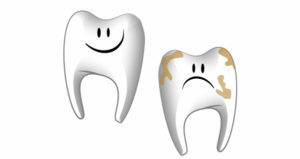
Often the plaque has a white or beige color. The consistency can be either plastic or solid. The color of the plaque is directly affected by the use of coffee or tobacco products.
Dentists have managed to establish the following regularity: lighter tooth deposits more often have a soft consistency, while they are formed faster than solid and can be deposited in large volumes. Dark - have a density of stone, but they are formed much more slowly and in less quantity than light ones.
Stages of formation of a dental plaque
The place of occurrence and speed of occurrence of a touch directly depends on individual features of the person, and also on the quality of hygiene of the oral cavity. 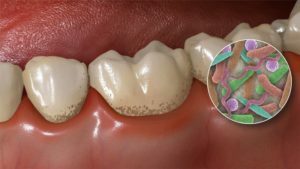
The plaque is formed in three stages:
- The first .Formation of the primary pellicle that covers the whole tooth or part of it.
- Second .Primary microbiological seeding.
- Third .Preservation on enamel.
Methods for diagnosing the disease
The plaque is important to distinguish from other forms of tartar. With the help of modern research methods, it is possible to comprehensively study the state of the patient's oral cavity and accurately determine the etiotropic pathogen.
The diagnostic process is carried out within the framework of modern laboratory diagnostic methods.
The use of such research techniques allows the patient to be diagnosed with high accuracy and choose the most appropriate treatment strategy.
In modern medicine, the following diagnostic methods are used to diagnose inflammatory and pathogenic processes in the oral cavity:
- complete examination of oral microflora;
- study of the state of the patient's immune system;
- biochemical studies;
- cytological studies.
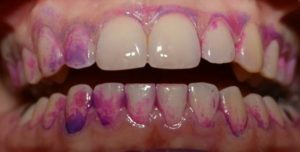 The success of the treatment of a plaque directly depends on the precise definition of the causative agent of this pathology. For diagnostics in some cases, use special dyes( as shown in the photo on the left), which help to establish the cause of the raid.
The success of the treatment of a plaque directly depends on the precise definition of the causative agent of this pathology. For diagnostics in some cases, use special dyes( as shown in the photo on the left), which help to establish the cause of the raid.
Microscopy of the oral cavity can be used to determine the microflora and to search for pathogenic agents of plaques.
To quantify the detected pathogenic microflora, a standard microbiological seeding of a selective or nonselective medium is used.
Further, there is a direct count of the detected microbiological colonies.
What are the methods of treatment
To remove all kinds of deposits on the teeth it is customary to use special dental methods, but certain results can be achieved also by home cleaning methods.
Removal of dental plaques by the professional method
Degassing begins in the distal area of the teeth. After this, the doctors move in the mesial direction, approaching the front teeth.
With the right approach and following the recommendations of the treating dentist, you can achieve complete victory over the plaques.
Qualitative treatment consists in professional cleaning at the stomatologist and passes in two stages:
- Removal .Complete cleaning of the teeth from soft and hard deposits accumulated on the surface of the tooth enamel and in the gingival and paranormal pockets.
- Processing of .To avoid repetitive formations, all cleaned surfaces and depressions are coated with special antibacterial agents.
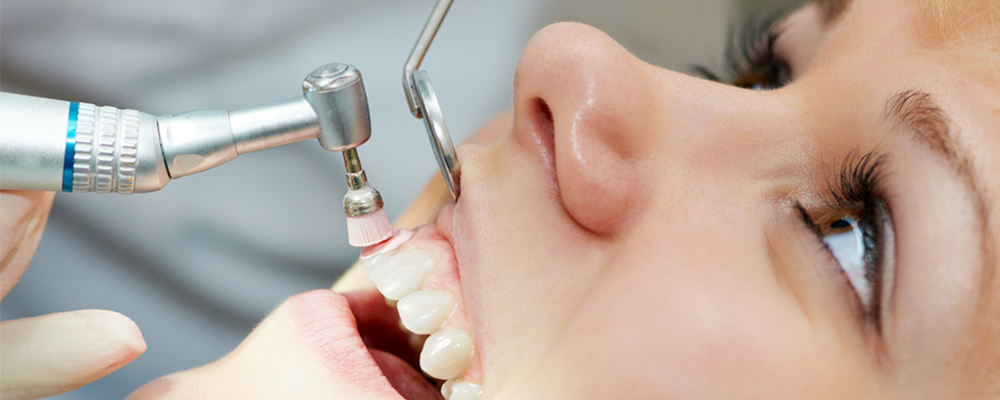
Treatment at home
At home, you can remove plaques with the help of mouthwashes with special dental solutions.
The use of compresses made of cotton wool and hydrogen peroxide can also help. But it is worth remembering that peroxide not only eliminates plaques, but also helps destroy enamel, which can cause more serious problems.
If home treatment methods do not work, you will need to see a doctor. Delaying time will only aggravate the situation and lead to tooth loss.
What are the consequences of ignoring
Plaque is not just an aesthetic problem, it is a cluster of pathogenic microorganisms that cause caries. As a result, the plaque, which has developed into caries, can cause partial or complete destruction of the tooth.
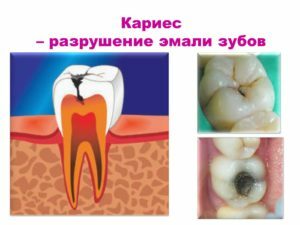
Also this pathology can become the beginning of the onset of periodontal disease and other gum diseases, which also often leads to the loss of healthy teeth.
This is due to the fact that the deposits squeeze the edge of the gums, which leads to its inflammation. As a result, the pathogenic microflora penetrates under the tooth and into the gum. Such serious consequences often have to be treated by surgical intervention and subsequent prosthetics.
Necessary prevention methods for
Prevention of the disease mainly consists of respecting the rules of oral hygiene.
Doctors believe that regular brushing of teeth after eating food is the most reliable way to minimize the likelihood of such a disease. When using high-quality toothpastes and brushes, you can remove the entire plaque until it is converted into a plaque.
The main rules of dental cleaning, which will help minimize the occurrence of pathology:
- application of medium-hard brushes with a small head;
- application of pastes containing fluoride in their composition;
- thorough brushing of teeth twice a day for at least 5 minutes;
- use of special balms that can dissolve biological plaque;
- application of yarns for deep cleaning of crevices between teeth;
- brush replacement at least once every two to three months.
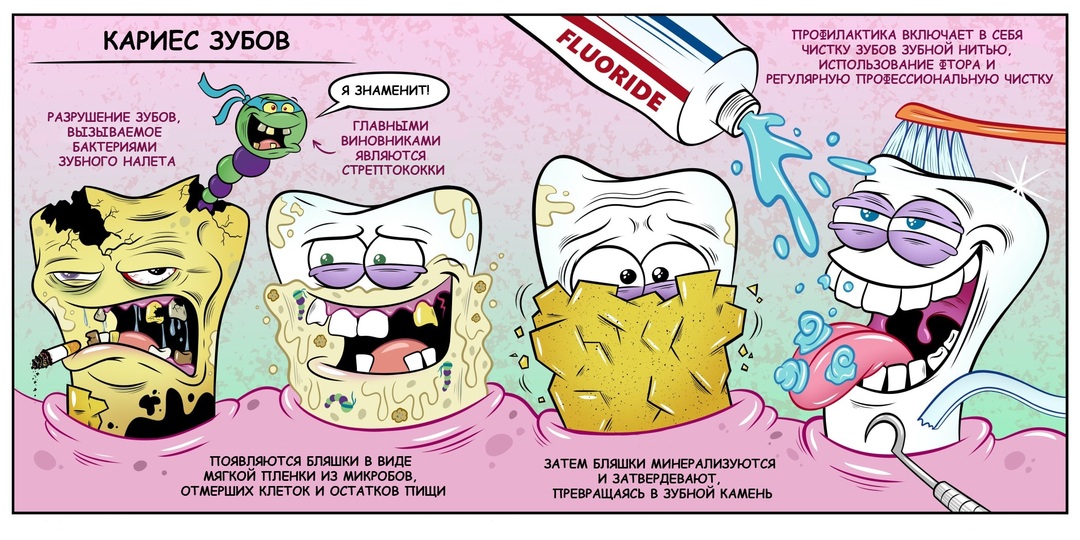 For children and people who have problems with mobility of hands, electric brushes are better suited. They have special rotating and moving elements for better cleaning of the oral cavity.
For children and people who have problems with mobility of hands, electric brushes are better suited. They have special rotating and moving elements for better cleaning of the oral cavity.
Dental plaques are not just a plaque that appears during the day and is easily brushed off. This is a serious pathology, which can cause serious diseases of teeth and gums.
Timely treatment by removing plaques can prevent the development of more serious oral diseases, which often lead to partial or complete loss of teeth.
